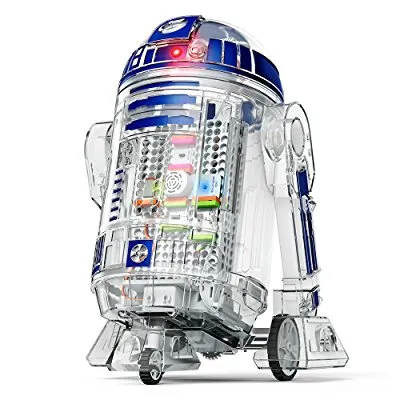
Kids from 1 to 92 this holiday season will be happy to “get off the couch and go play” with all the interactive, engaging smart toys and apps on the market this year. What’s important is how smart tech is changing the landscape not only of how organizations serve customers, but how we engage in play and entertainment, from children to adults as a means of a more immersive, educational experience. Great tech enhances our culture as a whole. The trend is veering away from tech toys as simple entertainment, but increasingly as a means to engage kids with a cerebral, educational focus. The jury is out on whether coding should be an essential core curriculum, with some experts speculating that conversational programs will allow us to program just by telling a system what we want it to do. But, it’s just as safe to say that the curve in pay, employment and opportunity trends toward skilled tech professionals. And this holiday season, the popular toys and apps for kids all seemingly have one thing in common: they’re high-concept and brilliantly executed. Here’s a look at how AI and smart tech is leading the way in transforming how kids can learn and have fun this holiday season.
Maker Gifts
[caption id="attachment_326" align="aligncenter" width="400"]

Source: littleBits[/caption]
Star Wars Droid Inventor Kit by littleBits
This toy is marketed to kids, but more than likely, many adults have all wanted their very own R2 unit (right?) littleBits has answered with a perfect makers gift for this holiday season. This kit allows kids to think originally and critically by assembling, both physically and electronically, their own R2-D2-inspired droid unit. The toy comes with “6 bits” or electronic components, the droid parts, customizable stickers, so that no two droids look the same, and an app to program it to do really cool stuff:
- Without touching it, pretend you’re using the Jedi force and guide your droid with your hand.
- “Help me Obi-Wan.” Record a secret message to your unit and send it on its way to deliver the message.
- A drawing tool attachment allows your droid to draw a map (of the Death Star, perhaps?).
- Program your droid to complete an obstacle course.
- Or, take the parts and apply them to other household items, to make your own unique droid.
- It offers endless opportunities to create and program to add onto the droid. Kids can expand on the droid with other littleBits parts (or bits) than the six provided in the kit.
This smart toy underpins the coming reality in education instruction as more and more educators are focusing on creating tech-skilled learners. In Finland, coding and programming are part of the national curriculum, where students in primary grades learn the basics of computing––without even using a computer. Educators there bring real-life application to the lessons, across all areas, to demonstrate the process of a sequence, i.e. knitting, for instance, to help students understand looping and sequence. A kit like this one excellently blurs the lines between learning and fun for kids––and adults. Building your own smart robot bridges the gap between consumers and “techies,” creating an inclusive, broader "Makers" culture.
Cozmo for Coding
Finally, someone designed a real-life Wall-E for our kids-and adults-it's that engaging. Cozmo launched last holiday season, but the robot is still as popular as ever this season. It’s also accessible as far as the more spendy toys go at just under $140.The small robot has expressive OLED lights, designed, largely, to emote. Its continuous track wheels allow for easy, stable mobility which is a nod to kids' enthusiasm for construction vehicles and components. Touted to “evolve as you hang out with it,” the toy robot embodies our perception of the future of AI.Anki also offers SDK (software developer kits) for many Cozmo components: Per , “With enough attention and love to it...this could be the most capable STEM platform that ever existed." says Anki CEO Boris Sofman.But what places Cozmo squarely on this list is that it’s one of the best examples of advanced AI combined with excellent emotional and physical design qualities, which make this toy so popular. Cozmo shows off the potential of machine learning advancement.
Simple Robotics Toy
Fingerlings! Your Very Own Monkey (or Unicorn, or Sloth)
Source: WowWee YouTubeIf you haven’t heard of Fingerlings, chances are, you’re not a parent? Yes, these are for kids, but they’re so cute they should probably be hanging around in your office, too. Fingerlings are crafted after a pygmy marmoset at the behest of WowWee owner Sydney Weisman, to realize her childhood dream of owning the Amazonian monkey . The 5” or so robotic toy grasps around your finger or any object, with its arms, legs or tail. It responds with over 40 adorable baby monkey sounds including burps, laughs and interacts in a variety of ways singing, sleeping, and whistling at you if you don’t pay attention to it after a minute. The toy has a number of sensors that have been utilized so simply and to perfection. Blow kisses and it blows them back, bounce it and it giggles. It’s a tricky and near-on unheard of mix in simplicity, automation and application to create a robotic product that isn’t a yawner. The touch of Japanese design aesthetic, small, bright and impossibly cute, doesn’t hurt, either. While this isn’t quite as high-tech, smart or AI driven, it’s struck a nerve because of it’s brilliant use of simplicity. Likewise, the toy exposes a broader audience who most likely have never heard of an Amazonian pygmy marmoset. When students have first-hand interactive experience, they’re more likely to have buy-in for broader, global affairs--which is a way to create more inclusion in what stands to be a generation encountering the need for more advanced technical skills to succeed. The company has also committed to donating $1 of every purchase to animal conservation.
Stocking Stuffer STEM Treat
DynePic-Staking the “Internet of Kids and Toys”
This app isn’t “quite” a toy. Rather, it's a safe social space for kids to learn and to connect with friends, complete with stringent, certified parental monitoring. In today’s digitally-driven world, where parents might question the best entry-point for their kids' online immersion, DynePic has found a way to potentially solve that. The company has been a forerunner in staking their claim within “The Internet of Toys” with wearables like DynePod, which allows kids as young as 5 to learn how to program.Dynepic offers compliance for full social and personalized access for kids from 5 and up. Parents or guardians are the only ones able to authorize friend requests, and kids can then safely talk to each other and even Santa. The application creates a safe, social connection for kids to learn and interact with other kids and friends. This holiday season, toys and kid-focused tech highlight that the next generation of innovators doesn't have to wait until they’re adults to change the cultural and tech landscape. Per a recent MIT Media Lab study,
We also loved that the older children we interviewed expressed the desire to design and program their own AI “friends.” We’re curious to explore how young people could help us researchers perceive future applications of AI and machine learning in new ways — as new modalities for expression, interaction, and creativity — and not only as tools meant to improve our productivity.
Have questions about designing your own chatbot? Check out the Ultimate Guide for Chatbots for Facebook.

